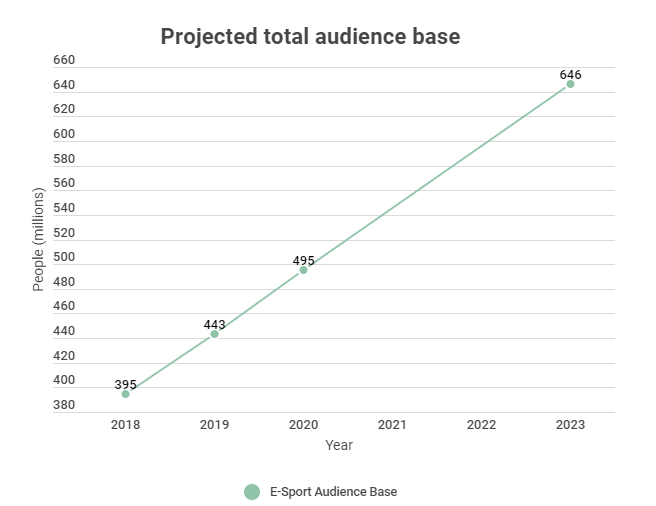Stats and Trends: Are E-sports The Future Of Australian Entertainment?
Last updated: May 12, 2021, 2:21AM | Published: Mar 11, 2021, 3:34AM
According to the Cambridge dictionary, sport is defined as “a game, competition, or activity needing physical effort and skill. One that's played or done according to rules, for enjoyment and/or as a job”. Somewhere E-Sport (Electronic-Sport) is pouring over those words and wondering where that leaves them in the scheme of things.
Boasting fierce competition and alluring prize pools, it’s hard to deny the enormous potential video games have where breaking into the traditional sporting scene is concerned.
But just how do E-Sports compare to Australia’s tried and tested pastimes such as Aussie Rules and rugby league, and what kind of scope do they have to make a legitimate imprint?
Are E-Sports just a passing phase, or do they have a serious role to play where the future of Australian entertainment is concerned?
E-Sports isn’t going anywhere soon
The consensus amongst experts is: No, sorry, E-Sports are here to stay.
And it’s an argument made against the backdrop of the E-Sport industry’s incredible ability to generate revenue:
Indeed, the past three years have shown that the Global E-Sports market, on average, generates 73.21% more revenue than AFL, and 159.18% more revenue than NRL. This revenue, not dissimilar to AFL or NRL is primarily earned via sponsorships and advertisements. Viewing platforms such as Youtube and Twitch have also been responsible for profound growth in viewership.
Online Resilience
While you can see a slight dip in the 2020 column for both physical sports in the graph above, this can be largely attributed to the COVID-19 pandemic which drastically reduced seating capacity for both codes and which contributed to estimated losses of 13.79% ($108M) and 21.02% ($111M) with AFL and NRL revenue respectively.
On the other hand, the E-Sport industry thrived during all the turmoil, experiencing a dramatic increase in revenue from 2019 to 2020 ($237M, 19.22%), largely attributable to being online and easily accessible. The average E-Sport consumer typically enjoys the sport (for free) from the comfort of their home, driving the industry’s financial resilience against external factors (like a pandemic) that ordinarily affect other sports.
Actual audience numbers?
Money is one thing. Actual interest is another. Surely, you might suggest, that video games don’t hold a candle against real sports regarding audience interest. The data, however, suggests otherwise:
Some say 'League of Legends' put E-Sports on the map and will forever keep its title as the king of E-Sports. And while cynics don’t think anyone is interested, the numbers don't lie.
While AFL and NRL suffer volatile view counts, the League of Legends World Championship maintains a steady increase of roughly 1% per year in total views. The 2021 League of Legends World Championship is forecasted to follow this trend, highlighting E-Sport’s force and durability.
Global outreach
Again, the reason for these impressive numbers is E-Sport’s accessibility. Whether you’re locked up in a boarding school in rural China, or living it up in the Bahamas, accessing E-Sport is as easy as pressing one blue hyperlink. Physical sports like AFL maintain a much more difficult system of access, with subscriptions, paywalls, and limited location access restricting who can watch what sport.
Total audience base projections
Perhaps you’re still unconvinced of E-Sport’s longevity? Physical sports like AFL and NRL have a strong history of success dating back more than one hundred years in Australia, as there's no proof that competitive video games can maintain the level of success it's currently boasting.
A fair argument, but professional market researchers disagree. They project the E-Sport audience base to grow 30.5% from 2020 to 2023 (roughly 10% increase per year) given similar growths were observed previous years.
Unfortunately, there are no professional projections for the AFL and NRL total audience count. If however, we base AFL/NRL audience growth on previous years, the projections still wouldn’t match the E-Sport numbers. The AFL and NRL audience both grew around 4% from 2019 to 2020, 6% less than the 10% growth achieved by E-Sports.
Variety
What is it about E-Sport’s that allows it to consistently attract new audiences? The key here is variety.
4,207 games were released (on the steam engine) in 2016. 2017 saw 7,049 games released, and 2018 saw 9,050 games. That’s around a 24% increase in the number of games pumped out every year. Of course not all games released will be E-Sport’s competitive, but it certainly makes it easier for new fans to be introduced into the world of competitive video-gaming.
Traditional sports do not have nearly as much innovation; most of the games played nowadays have been unchanged for decades, notwithstanding the AFL's frantic rule modifications in recent years. And so when people are looking to switch up the way they engage with a competitive landscape, E-Sport’s is the automatic go-to.
Is this the end for IRL-Sports?
Considering how revolutionary E-Sports is to the sporting industry, it is worth asking what is to become of our beloved traditional sports. Will there be less people participating in physical sport in the future? Is this the end of physical sport?
Some figures point to this fear being true. Australian demography studies found that only 20% of Australians regularly play competitive sports, down from 27% in 2001. The sports taking the biggest blow to its player base include Rugby Union (-63% participation), tennis (-35% participation), and squash (-67% participation).
Importantly, however, some sports have grown remarkably in participation levels, including soccer (+46%) and badminton (37%). Looking outside Australia, we have less reason to fear physical sport’s impending doom. Interest in Basketball and Baseball is on the rise in China and Japan respectively. For these select sports, E-Sports is a minimal threat.
Indeed, the entire Chinese Sports industry is expected to skyrocket within the next few years, with a growth rate around 20% each year. Despite the threatening presence of E-Sports, physical sport still maintains its powerful hold on the sporting scene, and it doesn’t look like its loosening its grip anytime soon.
Rather than suggesting a waning interest in physical sport, it may be more appropriate to assert that there is a shift in interest. Soccer and Basketball, like E-Sports, is more popular than it has ever been. The more sensible thought perhpas isn’t to fear E-Sport’s as the slayer of physical sports, but rather to embrace E-Sports as the next step in our ever-evolving sports/entertainment landscape.
Did you enjoy this article? Join our free mailing list to get the best content delivered straight to your inbox, or join the conversation by leaving a comment below or on the Stats Insider Twitter or Facebook page.







